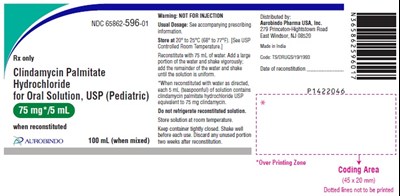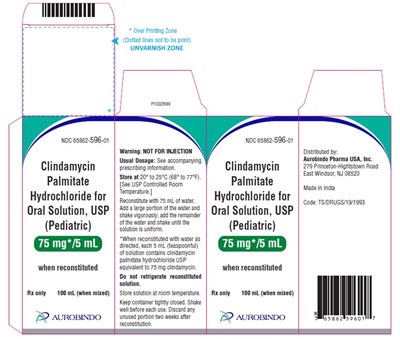Product Images Clindamycin Palmitate Hydrochloride (pediatric)
View Photos of Packaging, Labels & Appearance
Product Label Images
The following 3 images provide visual information about the product associated with Clindamycin Palmitate Hydrochloride (pediatric) NDC 65862-596 by Aurobindo Pharma Limited, such as packaging, labeling, and the appearance of the drug itself. This resource could be helpful for medical professionals, pharmacists, and patients seeking to verify medication information and ensure they have the correct product.
PACKAGE LABEL-PRINCIPAL DISPLAY PANEL - 75 mg/5 mL (100 mL Bottle) - clindamycin fig1

Clindamycin Palmitate Hydrochloride is an oral solution medication used for children, with a dose of 75 mg*/5 when reconstituted with 75mL of water. The solution should be stored between 10-25°C and should not be refrigerated. The medication is distributed by Aurobindo Pharma and should not be injected. The container should be kept dry and discarded after use, within two weeks of reconstitution. The text provides instructions on how to properly reconstitute the medication.*
PACKAGE LABEL-PRINCIPAL DISPLAY PANEL - 75 mg/5 mL Container Carton Label - clindamycin fig2

This is a description of a drug called Clindamycin Palmitate Hydrochloride for Oral Solution, USP (Pediatric), which is supplied as a powder to be reconstituted with water for oral administration. Each 5 mL (teaspoonful) of the solution contains clindamycin palmitate hydrochloride USP equivalent to 75 mg clindamycin. The drug is not for injection and should be stored at room temperature between 20°C and 25°C. The solution should be shaken well before use and any unused portion should be discarded two weeks after reconstitution. The drug is distributed by Aurobindo Pharma USA, Inc.*
* The product label images have been analyzed using a combination of traditional computing and machine learning techniques. It should be noted that the descriptions provided may not be entirely accurate as they are experimental in nature. Use the information in this page at your own discretion and risk.
